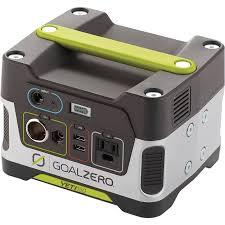It is all well and good escaping to the countryside every now and then to recharge our batteries, but it’s a fact of modern life that most of the things we have become so reliant on need more than just some burnt sausages and warm beer to keep their batteries charged. If you want to share photos of your sun burn on social media or continue to annoy your friends by playing the same album over and over on your portable speaker, you will need something to fill your devices with juice.
The Goal Zero Yeti 150 can power up your device in three different ways: you can use the USB port that charges all your medium-size USB powered devices, the 12V is best suited to charge all your medium 12V powered devices and the AC Inverter allows you to use the Yeti by plugging in your device just as you would in a wall socket. The Yeti 150 is designed for devices like smartphones, MP3 players, digital cameras, E-readers, tablets, portable lights, car adapters, laptops, DSLR camera batteries, display monitors and GPS systems. It will charge up your device roughly as fast as it would by plugging it into the mains at home - perhaps a touch slower, but nothing you would really notice. The LCD battery display will show you how much power you are getting - for example, a high-power charge might make the charge level of your Yeti 150 drop very quickly, so you won’t be getting the full 150Wh of power. However, if you're recharging devices that draw power more slowly, you will get closer to 150Wh consistently.
If you are in conditions likely to go below freezing, it is recommended that you keep the Yeti in an insulated cooler and connected to a power source (solar panels - this way, the natural heat generated by the Yeti 150 is contained and will keep battery capacity at its highest. Also, keeping the Yeti connected to a power source (solar panel or wall outlet) between uses or in storage will keep the battery in good health and prolongs its life. Obviously, it isn’t always practical to keep the battery plugged in all year round, so if you can’t, fully charging it every three months and storing it in a cool, dry place should help to maintain the battery.
The Yeti uses modified sine wave inverters, which work well with small electronic equipment - usually anything that includes an AC power cable with the box. However it isn’t suitable for fluorescent lights with dimming function, power tools employing "solid state" power or variable speed control, digital clocks with radios, and sewing machines with speed, so no alarm clocks, disco lights, DIY or haberdashery whilst you are away. It takes six hours to charge from a wall socket, eight from your car and between 3-52 hours from solar panels, depending on what kind you use. This will give you about 15 full charges of your smartphone, six charges of a tablet and 25 charges of your Go Pro.
One rather silly design flaw is when you plug a UK plug into the multi-regional socket, the plug then covers up the on off button, so you end up having to remove the plug without being able to switch it off first. The £180 price tag could also put off a lot of campers who are trying to save money by going camping in the first place. All things considered, though, we found the Goal Zero Yeti 150 a great little camping companion; it is compact, lightweight, robust and keeps your devices alive, allowing you to enjoy the great outdoors for longer. RRP £199
For Latest Price Click Below
3.9 out of 5
Pros
Compact
Light
Solid construction
Different power options
Quickly charges devices
Cons
Only suitable for medium power devices
Expensive
Multi-regional adaptors’ on/off button gets covered up
- Log in to post comments

